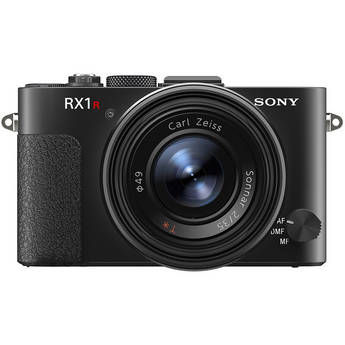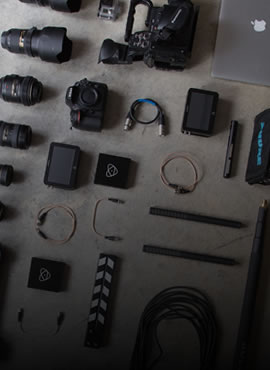Sony Cyber-shot DSC-RX1R Digital Camera
The Sony Cyber-shot DSC-RX1R Digital Camera is a compact
high-performance camera that features a large 24.3 megapixel full-frame
CMOS sensor to produce high resolution still imagery and full HD 1080p
video. Benefitting the performance of the sensor is the omission of the
optical low-pass filter, which allows for even higher resolution,
detail, and image sharpness than normally possible. Also contributing to
high overall image quality is the incorporation of the BIONZ image
processor, which enables low noise levels with high sensitivity to ISO
25600. Furthermore, this processor provides quick performance to all
aspects of the camera, including a full-resolution continuous shooting
rate of 5 fps, a high-speed autofocus system, and intuitive handling
throughout the menu system.
The RX1R's compact design incorporates a fixed Carl Zeiss Sonnar T* 35mm
f/2 lens, providing a standard wide-angle perspective that is suitable
for working in a wide variety of everyday conditions. This lens' bright
maximum aperture is suitable for use in dimly-lit conditions and also
benefits working with selective focus and shallow depth of field
imagery. The Carl Zeiss T* anti-reflective coating also benefits the
overall image quality by minimizing surface reflections and lens flare
and producing imagery with greater contrast and clarity.
One of the most revered elements of the RX1R is its compact form-factor
and as such, its inclusion of such a large sensor. The combination of
these two elements helps to realize truly outstanding imaging
capabilities in a highly portable and compact device. While small, the
physical design of the camera and lens integrates numerous facets that
provide efficient and intuitive use and control of exposure adjustments
and camera features. There are three distinct control rings on the lens
that give way to expedited handling of the focus, aperture control, and
macro settings and a range of physical control dials and customizable
buttons also allow for quick access to many different camera functions.
For composing imagery, playback and review, and navigating the menu
system, a large 3.0" 1,229k-dot Xtra Fine LCD monitor is available and
employs WhiteMagic technology to increase the screen's brightness to
support working in sunny and well-lit conditions. The design of the
camera also includes a multi interface accessory shoe, which, aside from
enabling the use of an external flash, permits mounting of an array of
accessories including optional viewfinders and external microphones.
- Full-Frame Sensor and BIONZ Image Processor
- The large 24.3 megapixel full-frame CMOS sensor provides a high level of image quality, detail, and rich color and tonal gradations with low noise levels. Greatly benefitting the capabilities of the sensor is the BIONZ image processor, which works to provide 14-bit RAW image data recording as well contribute to the overall speed of the camera. A broad sensitivity range from ISO 100 to 25600 enables clear low-light shooting and a full-resolution continuous shooting rate of 5 fps suits working with fast-moving subjects.
- No Optical Low-Pass Filter
- The optical low-pass filter (OLPF) has been removed in this camera in order to garner the greatest image sharpness and resolution from imagery. By removing the OLPF from the camera's design, there is no blurring of the image prior to capture in order to ensure the highest performance from both the lens and image sensor. This camera is ideal for users whose digital workflow typically consists of computer-based post-production processing as there is a greater likelihood of moir� or color artifacts occurring within image files produced without this filter.
- Carl Zeiss Sonnar T* 35mm f/2 Lens
- The Carl Zeiss Sonnar T* 35mm f/2 lens is a standard wide-angle lens with a bright maximum aperture that benefits working in difficult lighting conditions and for greater control over focus placement. The fixed focal length design ensures the highest image quality and the incorporation of three aspherical elements helps to minimize chromatic aberrations while also contributing to high overall sharpness. A Carl Zeiss T* anti-reflective coating has also been applied to lens elements to reduce lens flare and ghosting in order to produce imagery with high contrast and clarity.
- Full HD 1080p Video Recording
- Full HD 1920 x 1080 video recording is supported in multiple frames rates, including 60p, 60i, and 24p. When recording in full HD, the AVCHD Ver. 2.0 codec is used for highly detailed image quality that translates well to editing and sharing on HDTVs. Recording in the Internet-friendly MP4 format is also supported in 1440 x 1080 and 640 x 480 sizes at 30 fps. Sound is recorded during filming using the built-in stereo microphone or, alternatively, an external microphone can be used in conjunction with the multi interface shoe. When recording movies, full manual exposure control is possible by using the P/A/S/M modes, Creative Style and Picture Effect settings can be applied, and full-time continuous autofocus is also supported.
- Low-Light Performance
- A multitude of options are available to benefit working in dimly-lit conditions, including the bright f/2 lens, a maximum sensitivity of ISO 25600, and the incorporation of optical SteadyShot image stabilization to help minimize the appearance of camera shake. Additionally, the RX1R can capture six individual images in quick succession and combine data from each of the images into a single frame to help reduce noise levels by an equivalent two sensitivity steps.
- High Speed Autofocus
- Aided by the rapid throughput of the BIONZ image processor, high speed auto focusing is possible that is equally as precise as it is quick. Utilizing intelligent response data and a refined high speed actuator motor, the RX1R can acquire focus in a similar manner and speed to top-performing DSLR focus systems in a variety of lighting conditions.
- Camera Design
-
One of the most notable design elements of the RX1R is the lens
and its incorporation of three distinct control rings to provide an
efficient and intuitive means for adjusting focus, aperture settings,
and switching to macro focusing. By utilizing this analog system of
camera controls, you can maintain constant view of the image on the rear
monitor while being able to effectively fine tune exposure and focus
adjustments.
On the top plate of the camera are knurled control dials, which also lead to expedient changing of exposure modes and exposure compensation settings. Furthermore, a selector dial is located on the backside of the camera to enable switching between a variety camera adjustment settings and a front-located focus mode dial provides fast switching between AF, DMF, and MF focusing modes.
Five of the buttons on the rear side of the camera are customizable and can be reassigned to trigger functions as desired. The Custom, AEL, and Left, Right, and Down buttons can all be set to activate a wide variety of exposure, creative, and focusing settings. Once optimum camera settings have been found for a specific setting or effect, they can be saved using the Memory Recall mode and the same combination will be accessible for later use. Up to three groups of settings can be saved and each can be applied immediately by turning the control dial.
Finally, the design of the RX1R incorporates both a built-in pop-up flash and a mult interface accessory shoe. The pop-up flash has a guide number of 19.7' at ISO 100 and has a unique design that allows for tilting of the flash head for bouncing off of walls, ceilings, or reflectors. The multi interface shoe allows for the use of an external flash and also supports the use of a wide variety of optional accessories, including viewfinders and external microphones.
- High-Resolution LCD Monitor
-
Live view monitoring, image playback, and menu navigation are
all done from the rear 3.0" 1,229k-dot Xtra Fine LCD monitor. This
screen incorporates WhiteMagic technology to boost the overall
brightness of imagery to aid in viewing. An AR (anti-reflection) coating
and a layer of resin between the LCD and reinforced glass have also
been applied in order to minimize glare and produce deeper blacks and
more vivid color rendition. An illumination intensity sensor is also
integrated into the LCD's design to automatically adjust the brightness
depending on the ambient lighting conditions.
Using the screen during shooting benefits compositions through the inclusion of an optional gridline overlay to help line up horizontal and vertical lines within the image frame. Three distinct grids are available: Rule of Thirds Grid Line, Square Grid Line, and Diagonal + Square Grid Line. Additionally, a dual-axis digital level gauge can be used to determine camera roll and pitch for ensuring even horizons and plumb verticals. Benefitting focusing with the screen are the MF Assist and Peaking functions. MF Assist enlarges the live view image up to 11.7x to give a larger, more detailed view of the crucial elements. Peaking provides focus confirmation by highlighting the edges within the composition as a more objective means of determining critical sharpness when manually focusing.
In regard to menu navigation, the Quick Navi menu allows checking of current camera settings in a quick and intuitive manner. In this menu, you can easily adjust the most frequently used camera settings with the cross keys and control dial, and easy-to-recognize icons are used in place of text for faster recognition of these controls.
- Color and Tonal Rendition
-
The RXR fully supports Sony's proprietary TRILUMINOS Color
technology for producing imagery with an extremely broad color gamut for
viewing on TVs equipped with TRILUMINOS Display. During shooting, a
refined DRO (Dynamic Range Optimizer) can automatically analyze lighting
conditions in order to gain the greatest detail from shadow and
highlight regions of an image. This is especially useful when working
with backlit subjects or in high contrast situations. Five steps of DRO
are available depending on the scene at hand and these exposure
adjustments can even be applied during continuous shooting.
Auto White Balance (AWB) is an intelligent means for compensating for the effects of changing light sources within imagery by maintaining a consistent and neutral color temperature balance. A full range of manual white balance controls are also available, including custom white balance and color filter functions to fine-tuning the appearance of different color temperatures within imagery.
- RAW Image Development
- This PC software allows for advanced processing, handling, and editing of the camera's ARW 14-bit RAW image files. This software allows you to manipulate image's exposure, white balance, tonal curves, and other exposure and color settings as well as convert an image's color space and output as JPEGs or 16-bit TIFFs. Images can also be saved in other file formats, thumbnail portfolios can be created, Creative Style settings can be tuned, and images can be rated for more efficient editing.




